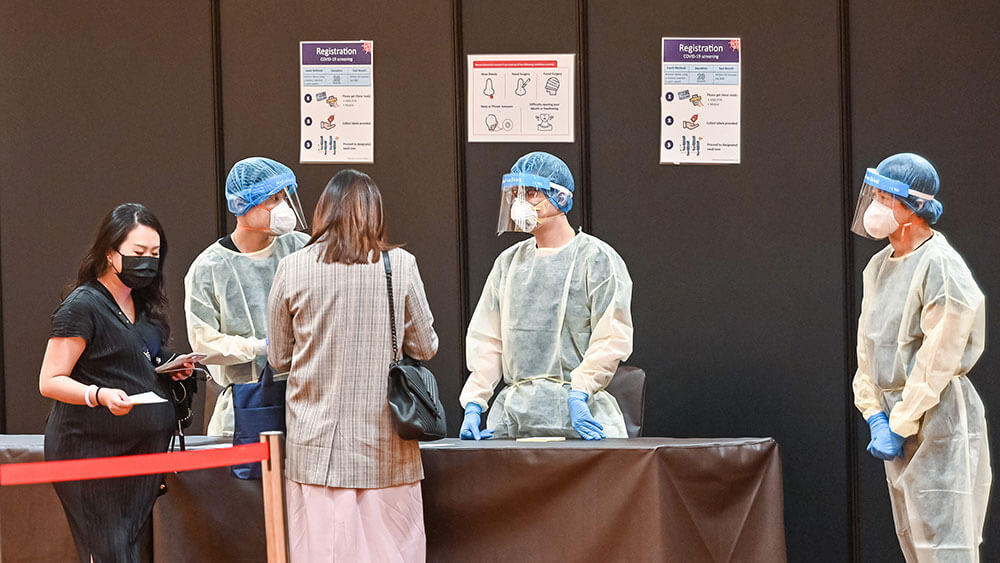
If you are planning enhanced health and safety measures at your event, such as the COVID testing done the Convening Leaders event in Singapore (above), clearly communicate the details to your attendees, exhibitors, temporary staff, and anyone else who will be involved in the on-site experience.

Kimberly Hardcastle-Geddes
As event professionals, it’s our job to plan the best experiences possible — and prepare for worst-case scenarios. So, how should we be approaching communications — specifically, crisis communications — in the midst of the ongoing COVID-19 pandemic? Here are a few recommendations from mdg’s team of public relations experts to guide you as you plan for future events.
Let Participants and Staff Know What to Expect Before They Arrive.
By setting expectations in advance, you’ll avoid issues later. Clearly communicate the details of enhanced health and safety measures to your attendees, your exhibitors, temporary staff, and anyone else who will be involved in the on-site experience. Make sure to include a code of conduct as part of the registration process, such as the wearing of masks and social distancing, and present it to employees in advance so that everyone understands expectations. Should you need to provide evidence that participants were made aware of — and agreed to abide by — your on-site safety protocols, you’ll be covered.
Define Roles, Audiences and Channels Early on.
Information travels fast, which is why you must be able to move faster. To be able to react quickly in the event of a crisis, make sure your team is clear on a few points early on:
- Task assignments. Designate a single spokesperson who will communicate with the media and ensure everyone on your team knows who’s in charge of which tasks (who’s monitoring social media, who’s contacting key stakeholders, who’s pausing scheduled content, etc.).
- Audiences: Know who you’ll need to notify and when you’ll need to notify them.
- Channels. You have an arsenal of communication methods at your disposal, including email, phone calls, SMS, and social media. Align them with your audiences to make sure you get the message across in the right way, at the right time.
Prepare (at Least Some of) Your Messaging Ahead of Time.
Have the following messaging essentials at the ready: a statement or press release, talking points and a robust Q&A to help your internal team tackle the tough questions. That way, you’ll be able to tailor your drafted messaging for the specific situation and get it out the door a lot earlier than if you were starting from scratch.
Develop your messaging with your legal team or advisor to ensure that you’re maintaining confidentiality, meeting your reporting obligations and being accountable and transparent without saying anything that could cause trouble later on. Also, don’t forget the cardinal rule of marketing — know your audience. By thinking about what your different audiences need — straight facts from your spokesperson, a genuine expression of compassion for attendees and exhibitors in your communications, etc. — you can make sure your messages resonate. While customization is definitely the way to go, anything you or your team drafts should be concise, clear, factual, express concern for your participants’ well-being, and explain the steps that were taken to protect their health, where appropriate.
Monitor and Respond.
If a situation does arise — for example, a participant or venue staff member gets ill or there is a spike in cases in your host destination — and you need to put your plan into action, it’s important to keep up on what’s happening, what people are saying, and what’s working. Leverage social listening, Google alerts, searches for key terms and any other metrics or tools that will help your team monitor the current sentiment and developments, as well as determine which messages are most effective. Every situation is different, which is why staying agile and proactive is critical.
Evaluate.
All experiences are learning experiences. After the dust settles, call a team meeting and, together, look at what happened, which channels and messages worked best and what could have been done better. Hopefully there isn’t a “next time,” but if there is, you’ll be even better prepared.
Kimberly Hardcastle-Geddes is chief marketing strategist at mdg, a full-service marketing and public relations firm specializing in B2B events.
